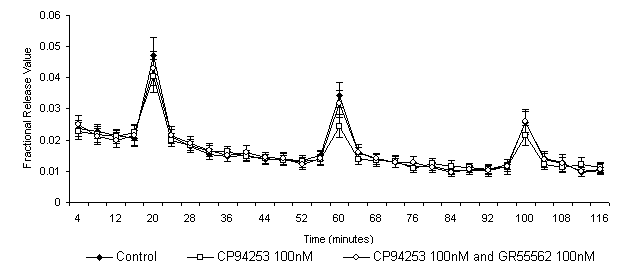| pA2 online © Copyright 2004 The British Pharmacological Society |
088P
University of Newcastle Winter Meeting December 2004 |
Identification of 5-HT1B autoreceptors on hyperstriatal neurones of broiler chickens G. Jackson., 1A.B.M. Raj., M.D.M. Lalies.& A.L. Hudson. Psychopharmacology Unit, University of Bristol BS8. 1TD and 1Division of Farm Animal Science, University of Bristol BS40 5DU. |
|
We have previously reported the presence of functional D2 like autoreceptors on chicken hyperstriatum neurones (Jackson et al., 2003). We have now investigated the nature of the central 5-HT autoreceptor in this species by examining the effects of a selective 5-HT1B agonist, CP94253 (5-propoxy-3-(1,2,3,6-tetrahydro-4-pyridinyl)-H-pyrrolo[3,2-b]pyridine hydrochloride) and the selective competitive 5-HT1B antagonist GR55562 (3-[3-(dimethylamino)propyl-4-hydroxy-N-[4-(4-pyridinyl)phenyl]benzamide dihydrochloride) on the in vitro release of [3H]5-HT.
Broiler chicken hyperstriatum (White Leghorn, either sex, 2.0-2.5kg) was dissected post mortem, cross chopped (0.3mm3) and preloaded with 0.1 µM [3H]5-HT (37 MBq/ml), in oxygenated Krebs (30 min,
37 °C, ascorbate acid 0.4mM). Tissue was superfused (Harvard Apparatus) with Krebs (0.4ml min-1) and stimulated (3Hz, 20mA, 2msec pulse width for 2 min) at 3 time points S1, S2 and S3. The tissue was incubated with ligands between t=36 and t=64min. 4 min fractions were collected and [3H] content determined by liquid scintillation counting.

Electrical stimulation evoked a transient release of [3H]5-HT from the tissue and initial experiments demonstrated the Ca++ dependent and TTX sensitive nature of the evoked release, confirming the authenticity of the [3H]5-HT released using TLC. The 5-HT1B agonist CP94253 (100nM) reduced the evoked release of [3H]5-HT (Fig 1) and the S2/S1 ratio of the CP94253 treated tissue was significantly lower than control ratio (two-tailed Students t-test, P <0.05, n=6). This effect was reversible on removal of the drug (Fig 1, S3). Following incubation with a 5-HT1B antagonist, GR55562 (100nM, which was without significant direct effect), the effect of CP94253 was attenuated and the S2/S1 ratio of the CP94253 and GR55562 treated tissue was not different to control (two-tailed Students t-test, P>0.05, n=6). These results indicate the presence of functional 5-HT1B autoreceptors on the terminals of broiler chicken hyperstriatal neurones.
Jackson G. et al. (2003) Br. J. Pharmacol., 138, Proceedings Supplement 175P.